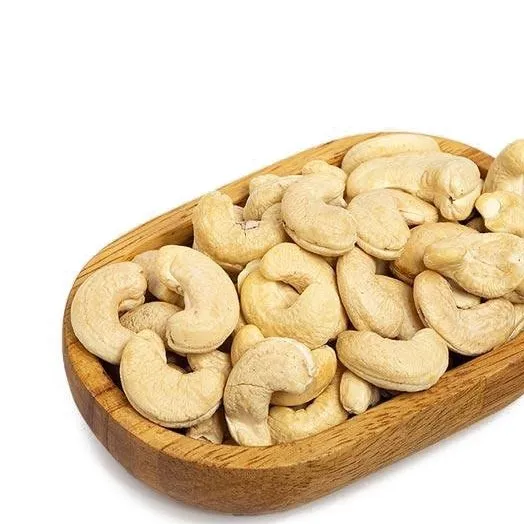Cashews, scientifically known as Anacardium occidentale, are not only delicious but also nutritionally rich nuts. They are widely consumed around the world in various forms, including as a snack, in cooking, and as a topping. In this article, we will delve into the unshelled cashews, exploring their nutritional benefits, versatile applications, and their significance in the global market.
1. Nutritional Profile of Unshelled Cashews:
Unshelled cashews, also known as whole cashews, are cashew nuts that are still encased in their outer shell. Despite being unshelled, their nutritional value remains intact, offering an array of health benefits. Here are some key elements of their nutritional profile:
1.1. Healthy Fats:
Unshelled cashews are an excellent source of healthy monounsaturated and polyunsaturated fats. These fats contribute to cardiovascular health, reduce bad cholesterol levels, and improve brain function.
1.2. Protein Content:
Cashews are a good source of plant-based protein, making them a valuable addition to vegetarian and vegan diets. The protein content in cashews helps in tissue repair and muscle building.
1.3. Essential Minerals:
Unshelled cashews are rich in essential minerals like magnesium, phosphorus, potassium, zinc, and iron. These minerals are vital for maintaining bone health, boosting the immune system, and aiding in energy production.
1.4. Vitamins:
Cashews are a good source of various vitamins, including vitamin E and B vitamins such as thiamin, riboflavin, and niacin. These vitamins exhibit antioxidant properties, promote healthy skin, aid in blood cell production, and support cognitive functions.
2. Culinary Uses and Versatility:
The culinary versatility of unshelled cashews makes them a popular ingredient in various cuisines around the world. Whether used as a garnish, a creamy base, or a crunchy topping, cashews add a unique flavor and texture to a wide range of dishes. Here are some popular culinary uses of unshelled cashews:
2.1. Snacking:
Unshelled cashews, when roasted or spiced, make for a delicious and nutritious snack on their own. They can be enjoyed as a satisfying mid-day treat or incorporated into trail mixes for an energy boost.
2.2. Ingredient in Savory Dishes:
Cashews can be ground into a fine powder and used as a thickener in creamy sauces, soups, and curries. Their natural creaminess and mild flavor make them an excellent dairy substitute in vegan or lactose-free recipes.
2.3. Baking:
Cashews, when crushed or finely chopped, add a delightful crunch to various baked goods, including cookies, cakes, and bread. They can be used both as a topping or incorporated into the dough or batter.

2.4. Nut Butter:
Unshelled cashews can be processed into a smooth and creamy nut butter. This versatile spread can be used on toast, in sandwiches, or as a dip for fruits and vegetables.
3. Global Market and Consumption Trends:
The consumption of cashews has seen a steady rise over the years, due to their delightful taste, nutritional benefits, and versatility in culinary applications. Here are some key insights into the global market for unshelled cashews:
3.1. Major Producers:
Unshelled cashews are primarily grown and exported from countries such as India, Vietnam, Brazil, Nigeria, and Tanzania. These regions provide favorable climate conditions for cashew cultivation and account for a significant share of global production.
3.2. Growing Demand:
Increasing health-consciousness and the rising popularity of plant-based diets have contributed to the growing demand for unshelled cashews. Consumers are seeking nutritious and natural alternatives, driving the market for whole cashews.
3.3. Export and Import Trends:
The global cashew market is characterized by a complex supply chain, with cashews being exported from producing countries to importing countries. Key importing nations include the United States, European Union, United Arab Emirates, China, and Japan.
3.4. Market Expansion:
Cashews are not only consumed as a snack but also find extensive use in the food processing industry, where they are used in the production of confectionery, cereals, and snacks. The expanding scope of application and the development of new cashew-based products contribute to the overall demand for unshelled cashews.
Conclusion:
Unshelled cashews are a nutritional powerhouse and a versatile ingredient that offers numerous health benefits and culinary possibilities. With their remarkable nutritional profile, they prove to be a great addition to a balanced diet. Whether consumed as a snack, incorporated into savory dishes, or used in baking and spreads, unshelled cashews continue to be appreciated worldwide for their rich flavor, creamy texture, and diverse applications. As the global demand for healthy, plant-based food increases, unshelled cashews are likely to remain a popular choice for both consumers and food manufacturers alike.The Unshelled Cashews: A Booming Business Opportunity
1. Introduction to the Cashew Industry:
The cashew industry has experienced significant growth in recent years, driven by increasing consumer demand for healthy and plant-based food options. Unshelled cashews, in particular, have emerged as a popular choice due to their nutritional benefits and versatile culinary applications. As a result, the cashew industry has become an attractive business opportunity for entrepreneurs and investors looking to capitalize on this growing market.
2. Market Analysis and Growth Potential:
2.1. Global Cashew Market Size:
The global cashew market was valued at approximately $9 billion in 2020 and is projected to reach $12.71 billion by 2026, growing at a CAGR of 5.3% during the forecast period. The increasing awareness about the health benefits of cashews and the rising popularity of vegan and gluten-free diets are primary drivers of this growth.
2.2. Regional Markets:

The United States, Europe, and Asia-Pacific are the key markets for unshelled cashews. The United States alone accounts for a significant share of global cashew consumption, driven by the growing demand for healthy snacks and the rise in vegetarian and vegan lifestyles. Asian countries like India, Vietnam, and China are major cashew producers and consumers.
2.3. Health and Wellness Trends:
The increasing focus on health and wellness has led to a surge in demand for nutritious and natural food options, making unshelled cashews a popular choice among health-conscious consumers. The high content of healthy fats, protein, and essential minerals in cashews complements these trends, further fueling the market growth.
3. Supply Chain and Sourcing:
3.1. Cashew Cultivation:
Unshelled cashews are primarily sourced from cashew trees, which are native to regions such as India, Vietnam, Brazil, Nigeria, and Tanzania. These countries have favorable climate conditions for cashew cultivation and account for a significant share of global production.
3.2. Processing and Export:
Once harvested, cashews go through a rigorous processing cycle that involves removing the outer shell, drying, roasting, and grading. The processed cashews are then packed and exported to various markets worldwide. India and Vietnam are key processing and exporting hubs.
3.3. Challenges in the Supply Chain:
The cashew supply chain faces challenges such as fluctuating production volumes, climate change, and quality control issues. However, advancements in technology and improved farming practices are addressing these challenges, ensuring a steady supply of high-quality unshelled cashews.
4. Business Opportunities and Potential Ventures:
4.1. Wholesale Distribution:
Entrepreneurs can explore opportunities in wholesale cashew distribution. Establishing relationships with cashew producers and processors, and supplying unshelled cashews to supermarkets, health food stores, and other retailers can be a profitable venture.
4.2. Cashew Processing:
Investing in cashew processing facilities allows entrepreneurs to add value to raw cashews by shelling, roasting, and packaging them. Processed cashews can be sold as snacks, used as ingredients, or supplied to the food processing industry.
4.3. Cashew-Based Products:
Developing and selling innovative cashew-based products, such as cashew butter, cashew milk, and cashew energy bars, cater to the growing demand for healthy and plant-based alternatives to dairy and conventional snacks.
4.4. Contract Farming:
Establishing long-term contracts with cashew farmers can ensure a consistent supply of high-quality unshelled cashews. This approach provides stability in the raw material supply and enables farmers to receive fair prices and support for sustainable farming practices.
5. Marketing and Branding Strategies:

5.1. Health Benefits:
Leverage the nutritional benefits of unshelled cashews in marketing campaigns, highlighting their high protein, healthy fat, and mineral content. Emphasize their role in heart health, weight management, and overall well-being.
5.2. Culinary Versatility:
Promote the versatility of unshelled cashews in culinary applications. Highlight their use in savory dishes, baking, smoothies, and nut-based spreads, appealing to home cooks, chefs, and food enthusiasts.
5.3. Sustainable and Ethical Sourcing:
Highlight your commitment to ethical sourcing by partnering with cashew suppliers who prioritize fair trade practices, support local communities, and promote sustainable farming methods. Communicate the positive impact on both the environment and the livelihoods of farmers.
6. Competitive Landscape:
The cashew industry is highly competitive, with numerous players operating at different stages of the value chain. Key companies in the global cashew market include Olam International, Vietnam Agricultural Processing Company (Vina T&T Group), and Agrocel Industries Ltd.
7. Government Support and Regulations:
7.1. Agricultural Subsidies and Grants:
Many governments provide financial support and grants to encourage cashew cultivation and processing. Entrepreneurs can explore these opportunities to minimize initial investments and access support for research and development.
7.2. Quality Standards and Certifications:
Complying with industry quality standards and certifications, such as Good Agricultural Practices (GAP) and International Organization for Standardization (ISO), provides credibility and ensures adherence to food safety and hygiene regulations.
8. Key Challenges and Risk Mitigation:
8.1. Price Volatility:
Cashew prices are subject to market fluctuations, influenced by factors such as crop yields, climate conditions, and exchange rates. Businesses need to stay informed about market trends and adopt risk management strategies to mitigate price risks.
8.2. Supply Chain Management:
Managing the complex cashew supply chain requires efficient logistics, quality control, and timely shipments. Building strong relationships with suppliers and implementing robust inventory management systems is crucial for smooth operations.
8.3. Consumer Preferences and Competition:
Meeting evolving consumer preferences and competing with established brands require staying updated on market trends, investing in product development, and maintaining quality standards to differentiate from competitors.

9. Conclusion:
The unshelled cashew industry offers lucrative business opportunities, driven by the increasing demand for healthy and plant-based food options. With a focus on quality, sustainability, and innovation, entrepreneurs can tap into this growing market by exploring various ventures, such as wholesale distribution, cashew processing, and cashew-based products. Effective marketing, strong supply chain management, and strategic partnerships contribute to success in this competitive landscape. As the global cashew market continues to expand, entrepreneurs can leverage the nutritional benefits and culinary versatility of unshelled cashews to build profitable and sustainable ventures in this thriving industry.










